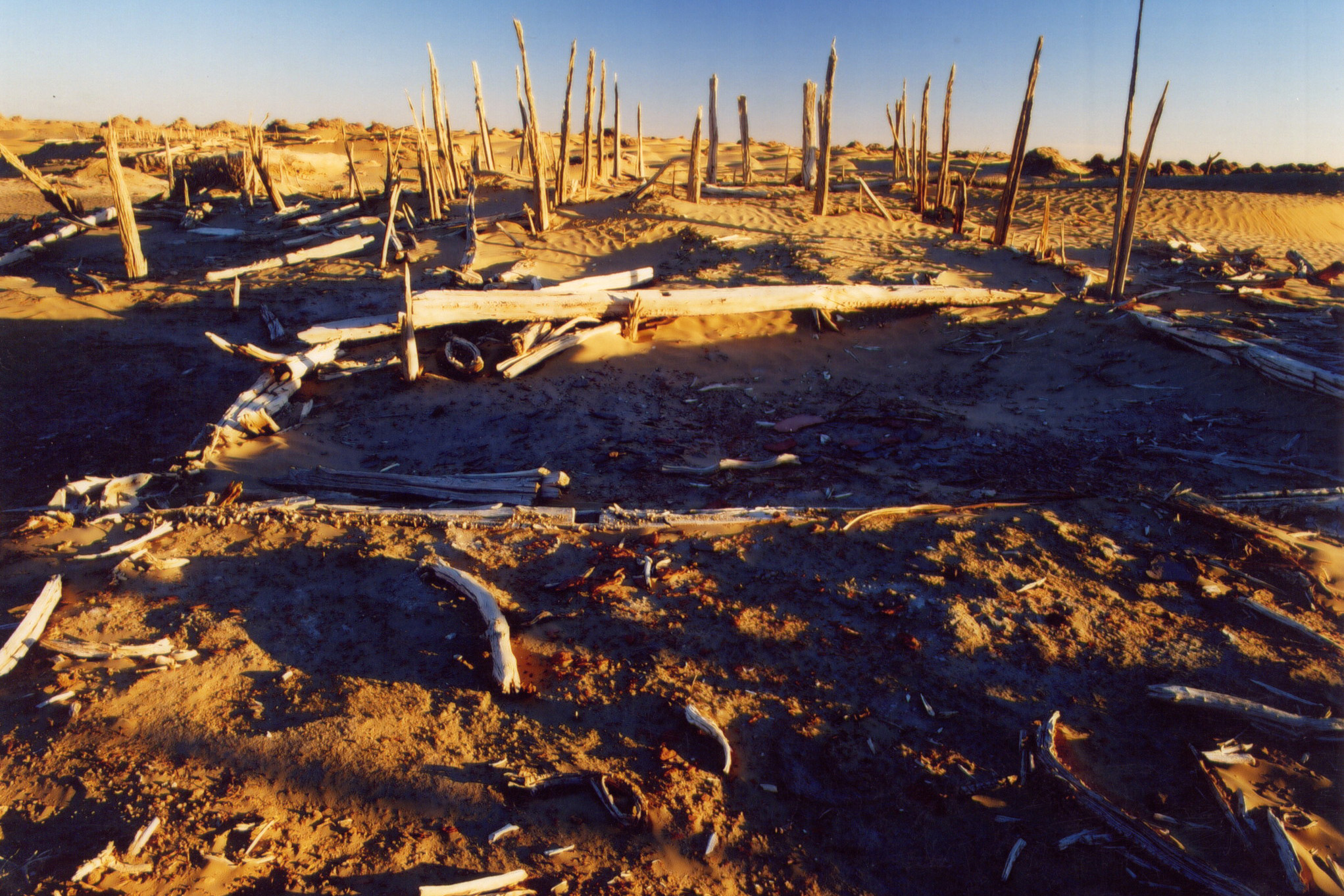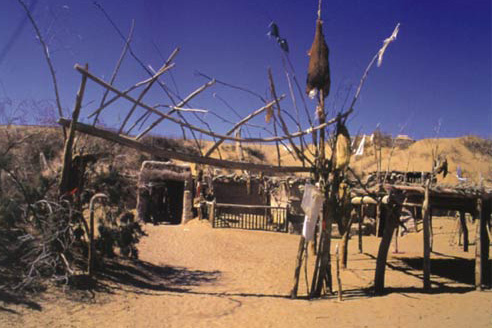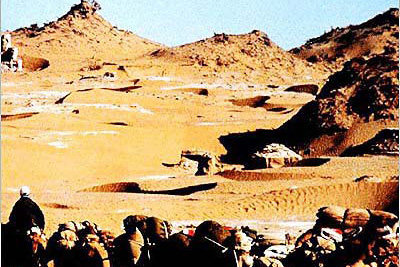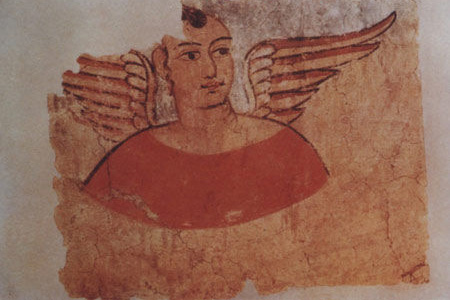Home > Attractions >
The Niya Site
Situated beyond the end of the Niya River, 100 kilometers to the north of Minfeng County Seat, the Niya Site consists of remains of a Stupa, Buddhist shrines, farmlands, dwellings, orchards, ponds, paths, kilns, cemeteries, and a circumvallation, etc., totaling more than a hundred. The site extends about 30 kilometers long from south to north and about 5 kilometers wide from east to west. Here is the old place of “Jinjue”, one of the 36 kingdoms in the Western Regions during the Han and Jin times, and is survival remains of “Cadoda” Prefecture of Shangshan. In 1995, a lot of seldom seen cultural relics were excavated from the site, including a silk brocade with Chinese sharacters “ 王候合昏千秋万岁宜子孙 ” , a brocade with Chinese words “五星出东方利中国 ”, bronze mirrors with designs of dragon and tiger, and so on. Now the site is listed as a major cultural site under state protection.
The Southern Silk Road (the 'Nan Shan Bei Lu') passes through China's Xinjiang province, following the northern foothills of the Kunlun Mountains and skirting the southern edge of the Taklamakan to Loulan, Khotan (Hetian), Yarkand and Kashgar (Kashi). At Kashgar the Northern and Southern Silk Roads merge.
The southern route was more strenuous to travel, as the oases along the way were more widely spaced than those of the northern route. In spite of this, the southern route was often preferred – its very remoteness meant that there was less likelihood of an attack by brigands.
Approximately half way between Korla and Kashgar on the southern route is the modern, fly blown oasis town of Minfeng ('New Niya'), perched precariously at the edge of the Taklamakan and lacerated by sandstorms. As late as the 1960s it still took 40 days to travel from Minfeng to Korla but the completion of the new Desert Highway – built to facilitate the exploitation of Xinjiang's vast oil reserves – means that the journey can now be completed in about eight hours. The drivers of the trucks that now race through Minfeng are probably oblivious to the fact that they are traversing a region that was once one of the richest kingdoms of the Silk Road.
During the first few centuries of the Christian era the southern route was controlled by the Shanshan Kingdom and merchants, monks and invading armies trudged through its cities. The survival of these towns was uncertain at best: the constant fear of attacks by nomads, of seismic activity and the drying up of the rivers that supplied them with water, led to a knife-edge existence for many of their inhabitants. Marco Polo provides a succinct description of the travails of the people along the southern route.
He passed through the "province of Charchan" (probably modern Qiemo, just to the east of Minfeng) in the 13th century and relates that the citizenry were so used to attack that they would flee into the Taklamakan at the first hint of danger:
"When they are aware of the approach of any body of troops, they flee, with their families and cattle, into the sandy desert, to the distance of two days' journey, towards some spot where they can find fresh water, and are by that means enabled to subsist".
The oasis towns of the southern road were eventually abandoned and reclaimed by the desert. They remained, for the most part, in a state of suspended animation until the early years of the 20th century, when explorers like Sven Hedin, Albert von Le Coq and Aurel Stein rediscovered them. Aurel Stein was particularly energetic and one of his greatest discoveries was the remains of Niya, about 100 kilometres northeast of Minfeng, deep in the Taklamakan. During visits in 1901, 1906, 1914 and 1931, Stein unearthed extensive remains at the site, indicating that it was once a major commercial centre on the Southern Silk Road. Situated at the western extremity of the Shanshan Kingdom, the town is referred to in a number of ancient documents as 'Cadota', and may even have been one of Shanshan's capitals.
It occupies a vast area beside the dried up bed of the Niya River – as much as 30 kilometres north to south and 5 kilometres east to west – and appears to have been abandoned around 350 CE when the river changed course or dried up and deprived it of its water supply. Most of Niya's structures are residential, but there are also Buddhist shrines and temples. Stein discovered about 40 different buildings here, most built with a strong wooden framework and, in many cases, with adjacent stalls for livestock.
The timber frames of many houses are still standing and the withered stumps of ancient orchards still protrude from the sand. Stein's description captures the desolate appearance of the site:
"Like the open sea the expanse of yellow dunes lay before me, with nothing to break their wavy monotony but the bleached trunks of trees or the rows of splintered posts marking houses which rose here and there above the sand crests".
The Southern Silk Road (the 'Nan Shan Bei Lu') passes through China's Xinjiang province, following the northern foothills of the Kunlun Mountains and skirting the southern edge of the Taklamakan to Loulan, Khotan (Hetian), Yarkand and Kashgar (Kashi). At Kashgar the Northern and Southern Silk Roads merge.
The southern route was more strenuous to travel, as the oases along the way were more widely spaced than those of the northern route. In spite of this, the southern route was often preferred – its very remoteness meant that there was less likelihood of an attack by brigands.
Approximately half way between Korla and Kashgar on the southern route is the modern, fly blown oasis town of Minfeng ('New Niya'), perched precariously at the edge of the Taklamakan and lacerated by sandstorms. As late as the 1960s it still took 40 days to travel from Minfeng to Korla but the completion of the new Desert Highway – built to facilitate the exploitation of Xinjiang's vast oil reserves – means that the journey can now be completed in about eight hours. The drivers of the trucks that now race through Minfeng are probably oblivious to the fact that they are traversing a region that was once one of the richest kingdoms of the Silk Road.
During the first few centuries of the Christian era the southern route was controlled by the Shanshan Kingdom and merchants, monks and invading armies trudged through its cities. The survival of these towns was uncertain at best: the constant fear of attacks by nomads, of seismic activity and the drying up of the rivers that supplied them with water, led to a knife-edge existence for many of their inhabitants. Marco Polo provides a succinct description of the travails of the people along the southern route.
He passed through the "province of Charchan" (probably modern Qiemo, just to the east of Minfeng) in the 13th century and relates that the citizenry were so used to attack that they would flee into the Taklamakan at the first hint of danger:
"When they are aware of the approach of any body of troops, they flee, with their families and cattle, into the sandy desert, to the distance of two days' journey, towards some spot where they can find fresh water, and are by that means enabled to subsist".
The oasis towns of the southern road were eventually abandoned and reclaimed by the desert. They remained, for the most part, in a state of suspended animation until the early years of the 20th century, when explorers like Sven Hedin, Albert von Le Coq and Aurel Stein rediscovered them. Aurel Stein was particularly energetic and one of his greatest discoveries was the remains of Niya, about 100 kilometres northeast of Minfeng, deep in the Taklamakan. During visits in 1901, 1906, 1914 and 1931, Stein unearthed extensive remains at the site, indicating that it was once a major commercial centre on the Southern Silk Road. Situated at the western extremity of the Shanshan Kingdom, the town is referred to in a number of ancient documents as 'Cadota', and may even have been one of Shanshan's capitals.
It occupies a vast area beside the dried up bed of the Niya River – as much as 30 kilometres north to south and 5 kilometres east to west – and appears to have been abandoned around 350 CE when the river changed course or dried up and deprived it of its water supply. Most of Niya's structures are residential, but there are also Buddhist shrines and temples. Stein discovered about 40 different buildings here, most built with a strong wooden framework and, in many cases, with adjacent stalls for livestock.
The timber frames of many houses are still standing and the withered stumps of ancient orchards still protrude from the sand. Stein's description captures the desolate appearance of the site:
"Like the open sea the expanse of yellow dunes lay before me, with nothing to break their wavy monotony but the bleached trunks of trees or the rows of splintered posts marking houses which rose here and there above the sand crests".







